TORS OF DARTMOOR EXTRA
a collection of extra material from the tors of dartmoor team
Favourite Tors of Dartmoor: The Tors of Dartmoor TeamPaul Buck, Tim Jenkinson and Max Piper on 13 June 2024 The Tors of Dartmoor Team An edited version of this article appeared in Dartmoor Magazine - Autumn 2022 Issue 147The Tors of Dartmoor team namely Paul Buck, Tim Jenkinson and Max Piper joined forces in July 2018 to create a lasting digital record of all the tors and rock piles that are set within the boundary of Dartmoor National Park (DNP) (www.torsofdartmoor.co.uk). Working with Eric Hemery's definition of a tor from 1983 as 'a prominent outcrop of rock that can occur at any point between valley floor and hilltop' and Richard Horsham's (2014) classification of tor types the trio set about documenting not only those that are most obviously shown and named on Ordnance Survey (OS) maps but also a whole series of lesser-known piles that despite being described in the literature are not always represented on modern cartographic depictions of the moor. In addition to this undertaking, a large expanse of the far eastern side of the DNP has also been explored revealing the existence of numerous and previously undocumented tors that are hidden under a dense canopy of trees that conceal their stature. Here in this short article each of the team members has the rather unenviable task of choosing three of their most memorable and stand out tors as must places to visit giving explanations for their choices. Paul Buck selects:Ashbury Tor SX 6051 9410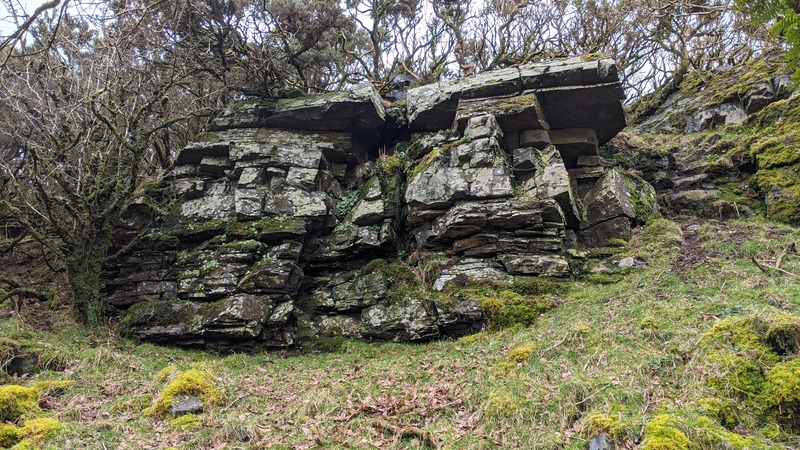 Ashbury Tor One of the draws for my move to Okehampton was the proximity to the delightful scene at Ashbury Tor and the woodlands below that line the East Okement and Moor Brook. The term 'bury' derives from the Anglo-Saxon 'burh', meaning a fort or fortified place and atop this spur of East Hill the ramparts of a camp are clearly visible, the tor being a significant natural part of the fortifications on its southern edge. When stood atop, above the treeline, 360-degree views are breath-taking. To the north you can see as far as Exmoor, to the south Dartmoor is set out before you with the deep green cleaves of Halstock Wood and West Cleave Gorge, and the Belstone and High Willhays ridges towering beyond. To the east, you get an unrivalled view of its neighbour, Cleave Tor. At your feet, there is little to suggest a tor, which is why it is still lesser known to this day. But venture beneath to a world of gnarly crags, sheltered in an oak canopy with a moss carpet that drops steeply to the valley floor. Here, the harsh sound of A30 traffic is muted, replaced by the therapeutic tumbling of the Moor Brook far below. Hemery writes: 'If Ashbury Tor, so easily accessible from the road on East Hill, were a visitor's first contact with Dartmoor, his pulses would quicken and imagination be fired beyond anything printed page or photograph could achieve, for here, heaving itself up fiercely from the patchwork of lowlands bordered by distant, hazy and gentle hills, Dartmoor begins.' Hucken Tor SX 5493 7382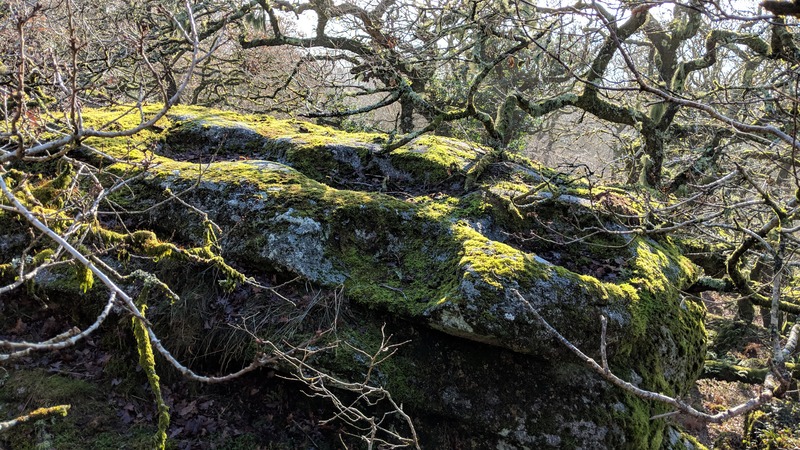 Hucken tor I've long been fascinated with woodland tors and perhaps the jewel of those would be the multiple outcrops at Hucken Tor. Each visit, I feel compelled to return and that, to me, is what makes it a favourite. The outcrops that can be seen above the treeline make this worthy of attention alone, but, like Ashbury Tor, it is when you drop among the oak that its real beauty is discovered. A sprawling collection of fine granite outcrops pepper the gentle slope, each one adorned in various moss and lichen species. To the north the scene opens up on a grassy shelf with views of Vixen Tor, the lesser-known Little Vixen and the giants of Staple and Great Mis high on the horizon. Further down beside the public footpath that leads from Merrivale to Daveytown, the visitor should seek out an outstanding collection of four rock basins on an outcrop above the southern gate. Black Tor (Okehampton) SX 567 894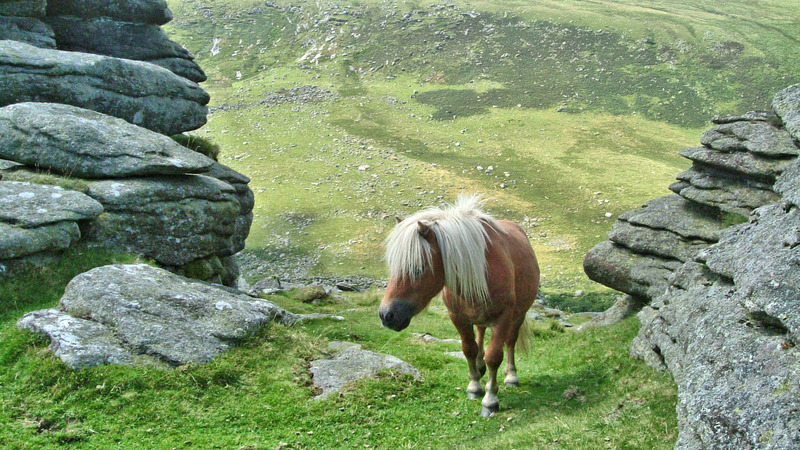 Black Tor (Okehampton) For many years I would escape the festive season on Boxing Day by walking from Meldon Reservoir, along the West Okement and up to Black Tor. Atop either of its three granite outcrops (or as Crossing called them; 'triple crowns') the walker is treated to one of the best views they can hope to see on the moor. Below lies the ancient oaks of Black-a-Tor Copse and the West Okement Valley, south-west across the river the exposed granite of the Slipper Stones glistens on the steep sides of Corn Ridge, which rises to Branscombe's Loaf further to the west. Shelstone Tor sits north-west, in front of a canvas of West Devon's patchwork fields and on a clear day you can see as far as the Cornish coast. But it is an encounter in the summer of 2007 that remains long in the memory when a pony wandered up to join me. Each return, I half expect to see her stood there at the lowest outcrop. Tim Jenkinson selects:Crow Tor SX 6062 7878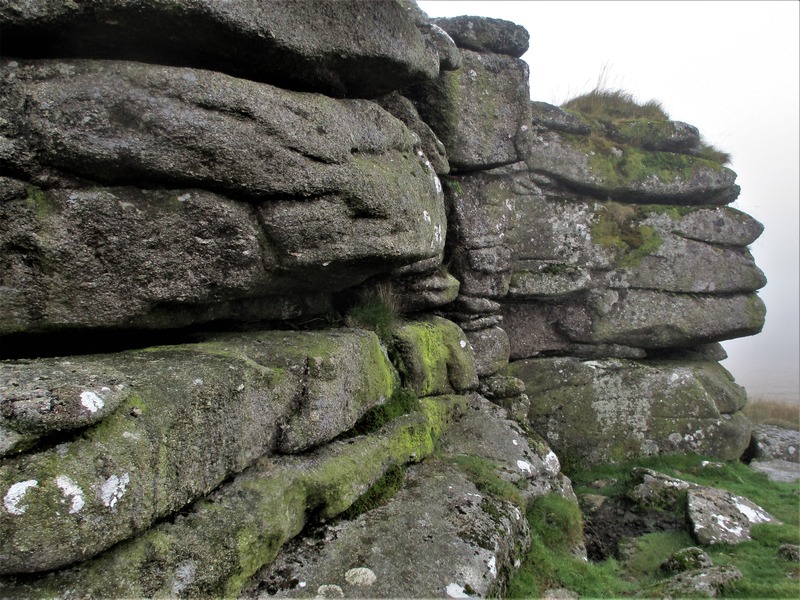 Crow Tor I have included this as one of my favourite tors as I always look out for it on the walk northwards from Two Bridges car park along the track above Wistman's Wood. It is such a conspicuous landmark with its unusual, rounded shape that occasions Hemery to liken it to a crouching bird although I have never quite appreciated that impression. At close quarters the tor is very impressive a huge knob of fissured granite with a sprawling clitter of broken outcrops to the south that are collectively known as Little Crow Tor. It is the western side of the main outcrop that is the best aspect where a towering rock face presents as a much better mimetolith than Hemery's assertion. In addition to this the views southward are splendid taking in the whole tor studded ridge of Longaford high above the West Dart River. Given that this very same river can be difficult to cross Crow Tor is perhaps better reached from the car park at Holming (Omen) Beam to the southwest, but should you choose this route you will need to check the live firing notices for the Merrivale Range as you will be passing through that area. Branscombe's Loaf SX 5530 8912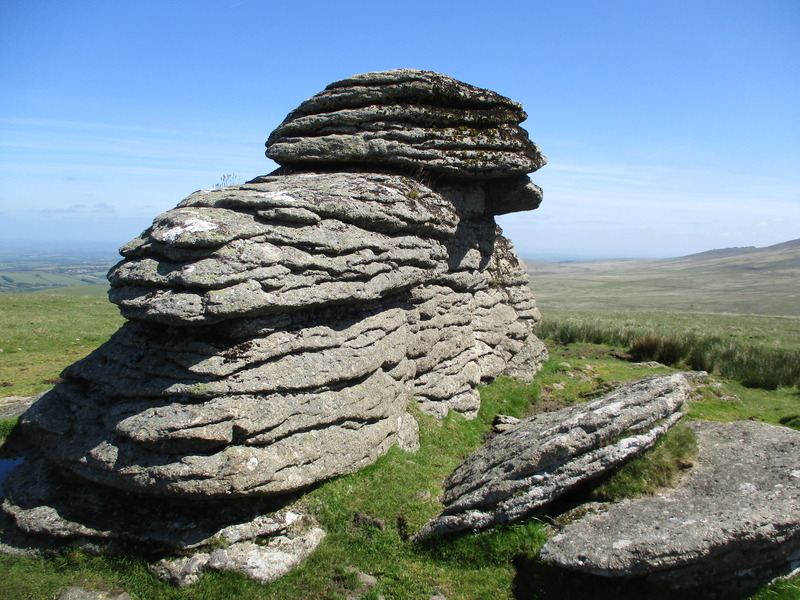 Branscombe's Loaf Not usually described as a tor but it fulfils all the criteria the Loaf atop Corn Ridge high above Shelstone Tor is associated with an enduring legend of the moor first described it seems by Sylvia Sayer in 1951 and is linked to the exploits of a hungry Bishop Bronescombe from 1260 who having encountered a stranger on the open moor offering him bread and cheese, espied a cloven hoof just in time and cried out to God as the stranger vanished. The bread and cheese is said to have turned to stone resulting in the names we use today for the main outcrop and the smaller one nearby. Legends aside this is an exhilarating hilltop the views to the north are magnificent taking in the extent of Meldon Reservoir (opened 1972) looking like a bright blue puddle in the far distance and then moving our attention to the right we see West Mill and Yes Tor with High Willhays and Fordsland Ledge on high and lower down on the slope where Black Tor's three outcrops lie. Away to the south Great Links Tor dominates the scene. A visit is thoroughly recommended as the landscape shows Dartmoor at its best. For me this was the first great view of the moor that I can remember from the late 1980s and it has left a lasting impression and a revisit in 2022 reaffirmed its stunning appeal. Dewerstone Rock SX 5387 6383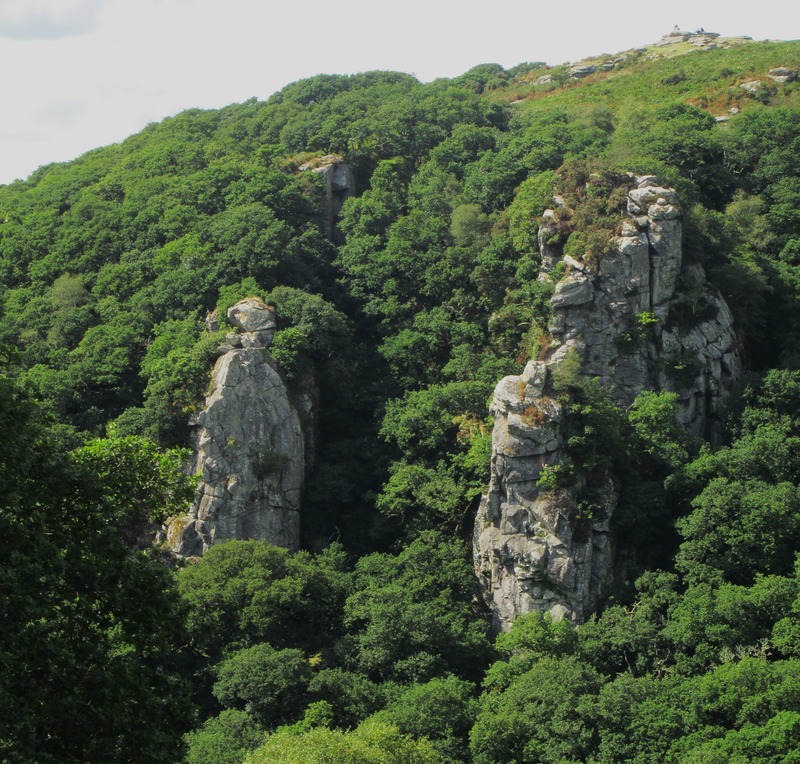 Dewerstone Rock This is simply a breath-taking dual cliff face of rock that sits high above the River Plym on the far south western edge of Dartmoor. Somewhat underrepresented in the literature, for me the Rock is best seen from the other side of the river on West Down, where its magnificence can be fully appreciated. Easily reached by walking south westward across Wigford Down from Cadover Bridge and passing the twin outcrops of Cadworthy or Oxen Tor along the way, the summit rocks of Dewerstone Hill are quite lowly and yet notable for the celebrated memorial to poet Noel Carrington who died in September 1830 aged 53 years. Following a narrow path downhill, the giant rock faces soon reveal themselves and the visitor cannot fail to be impressed by the towering crags to the left as the path descends and the roar of the river is heard below. Steep in places and although relatively well defined the path can still be slippery in wet weather. More rock piles can be seen away to the west where another substantial tor resides in the trees. This is quite separate to the main buttresses of rock and has therefore acquired the name of Dewerstone West in recent years. This is an altogether magical place of grand beauty that I never tire of. Max Piper selects:Birch Tor SX 6867 8143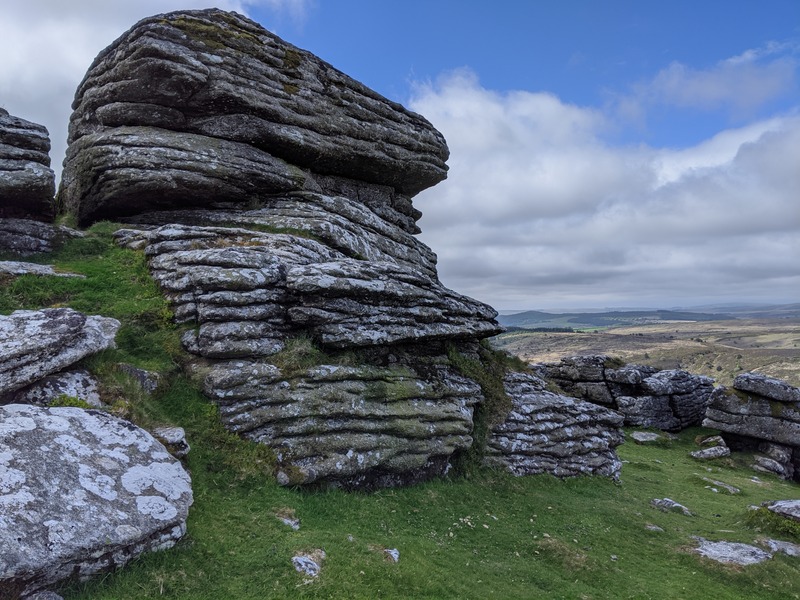 Birch Tor For me, Birch Tor will always have a special place in my heart. It always looks stunning on the skyline and has a wealth of history on its flanks and in the Redwater Brook valley. The tor itself is split into two pretty equal parts with distinctive horizontal jointing. I feel that its overall stature and eminence is greatly underrated which is unfortunate as it is such a lovely vantage point overlooking Challacombe Down and beyond to Bellever and Holne Ridge. I experienced a truly magical sunset here in July 2020 and find it to be a wonderful tor to visit on any occasion, especially as it can be reached with ease from Bennett's Cross to the west. Also well worth a visit, albeit with serious caution, are the impressive tin mining excavations of Chaw Gully, at SX 688 809; these deep scars from a once thriving industry have left exposed granite cliffs, almost resembling tors in their own rights. Whiddon Wood Tor SX 7274 8937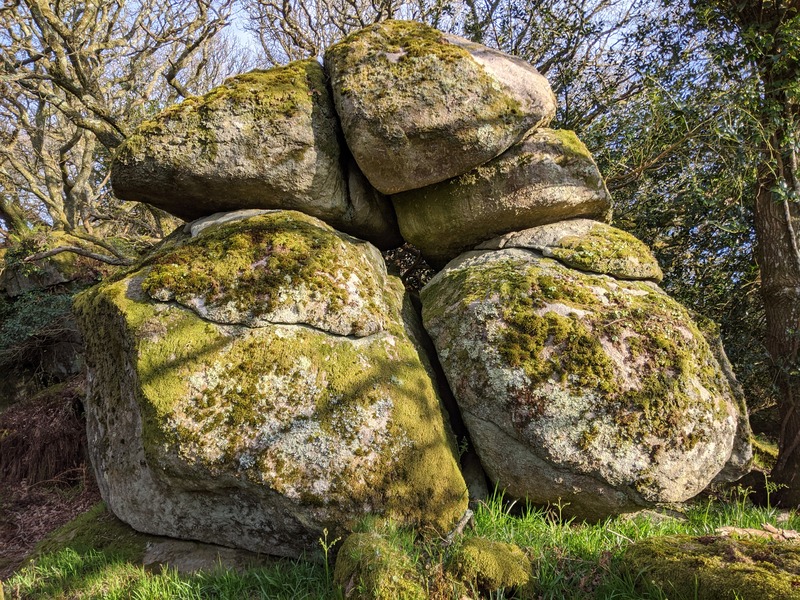 Whiddon Wood Tor East Dartmoor really is a stupendous place for finding hidden tors and rocks, many of which would quite easily rival the stature of those on the open moor that many of us are acquainted with. Secreted away in Whiddon Wood, opposite Castle Drogo, lies a huge tor that comprises several sprawling outcrops that emanate from the core near the top of the hill. Drawn to Tim Jenkinson's attention in 2011 by Dr Tim Harrod whilst undertaking his soil survey, he described it as a 'magnificent tor'. With breath-taking cliffs and boulders, all interspersed and accentuated by vibrant mosses and climbing plants. Whiddon Wood Tor is a delightful tor to explore. To visit, however, you will need to pass through a gate at SX 7254 8961, handrailing a massive wall to your right (this is used to keep deer in, or out, of Whiddon Deer Park). A couple of minor paths weave their way up the hill to reach the tremendous rocks and the visitor who finds himself here will, without doubt, be taken away by the magnitude of this neglected area. Little Kneeset SX 5856 8404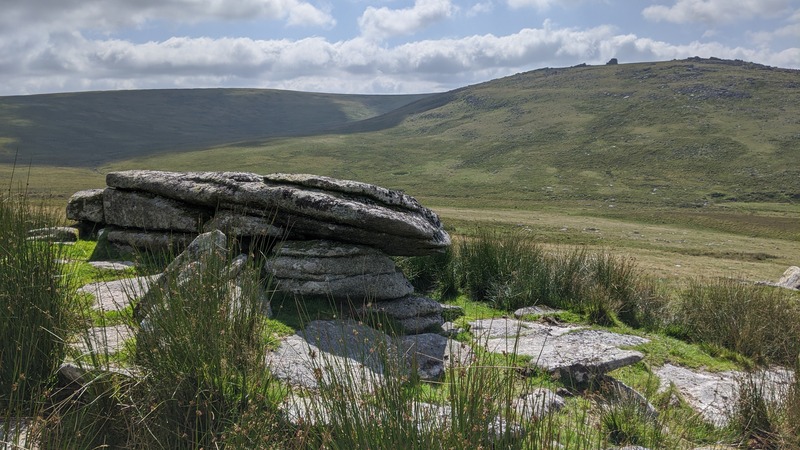 Little Kneeset Although it is overshadowed and encircled by higher, prouder eminences, Little Kneeset is nonetheless a worthy hill that every Dartmoor enthusiast should visit. With the best view of Fur Tor standing sentinel to the south, Little Kneeset is a place for solitude and quiet contemplation; on a clear day the scenery is spectacular. The hill itself, as Hemery explains, is better-known to the moormen as 'Pinswell', a name erroneously placed by the OS on the west flank of Fur Tor. The hill has two summits, the eastern one being higher and with a peat pass (Pinswell Cut); but it is the lower, western hump that I prefer as it has on its south side a beautiful overhanging rock, almost of small tor proportions. To sit here and marvel at the clittered slope of Fur Tor is to enjoy one of the most awe-inspiring scenes on Dartmoor truly in the wilderness. Approaching up the Amicombe Brook you will see that Little Kneeset is of surprisingly good pasturage, which resulted in it being part of the 'Preda de Vurtorre'. The hill is an altogether secluded place, rarely visited, that possesses a sense of bosom to me. It is wild and wondrous country and there is nowhere else quite like it. ConclusionThis concludes the snapshot of favourite tors from the Tors of Dartmoor team an appreciably difficult task to narrow down to three each but with personal memories and impressions attached it nonetheless provides an insight into how the three explorers continue to experience the wondrous moorland landscape in all its moods and ruggedness. References: |